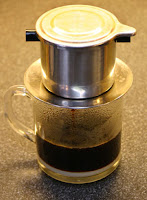Kona coffee is the market name for coffee (Coffea arabica) cultivated on the slopes of Hualalai and Mauna Loa in the North and South Kona Districts of the Big Island of Hawaii. It is one of the most expensive coffees in the world. Only coffee from the Kona Districts can be described as "Kona". The weather of sunny mornings, cloud or rain in the afternoon, little wind and mild nights combined with porous, mineral rich volcanic soil, creates favorable coffee growing conditions. The loanword for coffee in the Hawaiian language is kope.
The coffee plant was brought to the Kona district in 1828 by Samuel Reverend Ruggles, from Brazilian cuttings. English merchant Henry Nicholas Greenwell moved to the area and established Kona coffee as a recognized brand later in the 19th century. The former Greenwell Store and Kona Coffee Living History Farm have since become museums.
In other parts of the Hawaiian islands, it was grown on large plantations, but the 1899 world coffee market crash caused plantation owners to lease land to their workers. Most were from Japan, brought to work on sugarcane plantations. They worked their leased parcels of between 5 and 12 acres (49,000 m2) as family concerns, producing large, quality crops.
The tradition of family farms continued throughout Kona. The Japanese-origin families have been joined by Filipinos, mainland Americans, and Europeans. There are approximately 800 Kona coffee farms, with an average size of less than 5 acres (20,000 m2). In 1997 the total Kona coffee area was 2,290 acres (9 km2) and green coffee production just over two million pounds.
Kona coffee beans are classified according to seed. Type I beans consist of two beans per cherry, flat on one side, oval on the other. Type II beans consist of one round bean per cherry, otherwise known as a peaberry. Further grading of these two types of beans depends on size, moisture content, purity of bean type and size. The grades of Type I Kona coffee are Kona Extra Fancy, Kona Fancy, Kona Number 1, "Kona Select", and Kona Prime. The grades of Type II Kona coffee are Peaberry Number 1 and Peaberry Prime. There is also a lower grade of coffee called Number 3 which can not legally be labeled as "Kona".
Infestations of the root-knot nematode damaged many trees in the Kona districts in the 1990s. Symptoms are single or clusters of trees with stunted growth, especially when transplanted. In 2001, rootstock from the Coffea liberica species was found to be resistant to the nematodes. It could be grafted with Coffea arabica 'Guatemala' variety to produce a plant that naturally resists the pest, as well as produces a quality coffee product. The combination was named after Edward T. Fukunaga (1910–1984), who was superintendent of the University of Hawaii's Kona Research Station in Kainaliu in the 1950s through the 1970s.
Because of the rarity and price of Kona coffee, some retailers sell "Kona Blends". These are not a combination of different Kona coffees, but a blend of Kona and Colombian, Brazilian or other foreign coffees. Usually they contain only the minimum required 10% Kona coffee and 90% cheaper imported beans.
Current Hawaiian law requires blends to state the percentage of Kona coffee on the label. There is no matching Federal law. Some retailers use terms like Kona Roast, or Kona Style. To be considered authentic Kona coffee, the state of Hawaii's labeling laws require the prominent display of the words "100% Kona Coffee".
In the 1990s, a company called Kona Kai Farms, in Berkeley, California, was sued on behalf of Kona coffee growers. In October 1996, federal officials in San Francisco indicted Kona Kai Farms executive Michael Norton on wire fraud and money laundering charges. He was found to have put Central American coffee into bags with labels indicating it was Kona coffee since 1993. In 2000 Michael Norton pleaded guilty to one count of wire fraud and one count of tax evasion.
Some Kona farms have become successful tourist attractions. Although some roadside stands are allowed with special permits, large gift shops at some areas that are zoned agricultural have met local resistance.






